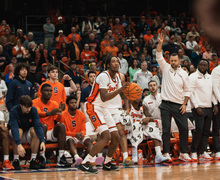Aikido club helps develop self-defense techniques, serves as outlet for students
Two claps from the sensei are the only sounds heard in the room on the lower level of Archbold Gymnasium. The group calmly stops and comes into “seiza,” or a proper seated position, to await the next movement instruction.
For more than a decade, the Syracuse University Aikido Club has practiced the martial art, moving in this cycle throughout a class that builds peace of mind, self-defense techniques and provides an escape for students.
“Silence is a way of culminating the Aikido body,” said Peter Katz, English doctoral student who has been studying Aikido for two and a half years.
Katz explained that a translation of the Japanese word would convey something like the way of energy, force and harmony.
The on-campus group cultivates this harmony and energy with three practices a week. Currently there are about 15 to 20 active members with different levels of experience. But the number frequently changes from semester to semester, and membership is open for participants to show up and study.
“You don’t punch, you don’t kick, you just redirect everything,” said Richard Thomas, who is new to the Aikido Club.
Thomas, a senior biology major, had previously studied taekwondo. He said that Aikido looks to receptive movement, whereas taekwondo and other martial arts tend to be more offensive.
“What I’ve noticed is that it’s different in the sense that you take your opponents energy and you use it against them,” said Nathan Brown, a junior computer arts major at SU.
Brown said that different “dojos,” or places of practice, take varying approaches to the art. Some focus on practical applications and real life scenarios, and others on the philosophical and relaxation factors.
“It’s not about hurting your opponent, it’s about making sure you can pin them down,” Brown said. “A practical use would be to pin someone down and call the cops.”
Like most martial arts, Aikido depends on mind and body. Full concentration channels the harmony and energies, as the movement responds instead of takes action.
A regular class structure for the Syracuse group begins with stretching, warming up and going through very basic stances. The students quietly mimic the movement as they begin and prepare for the rest of the class.
For the remaining time, the “sensei,” or teacher, will lead a cycle of the art, switching between demonstrating an encounter or movement and observing the group try it. The students will pair up and practice the conversation-like art, usually resulting in one of the partners rolling to the ground.
“I see it more as like testing what the limits of your body are,” Katz said, allowing his practice to answer questions such as: “Can I do a forward roll?” and “What does it feel like to get thrown over someone’s hip?”
While the level of experience is split, more familiar members whisper tips quietly to newer ones as they work on their meditative-like movements.
“If you are very good at this, it doesn’t require a lot of energy at all; you can go for hours without getting tired,” Thomas said.
Regular corrections and commentary come from the sensei to individuals throughout the evening and each time, the response is a quiet bow. All the while, these gestures are quiet and adjustments are made. The practice remains reverent and traditional, but there is a welcoming and eager atmosphere.
“While I’m upside down or in the air, I’m not thinking about finishing (qualifying exams) or what I’m going to teach on Wednesday,” Katz said. “It’s a way of just clearing my mind and relaxing.”
Published on November 14, 2012 at 1:38 am
Contact Adelyn: albieden@syr.edu





